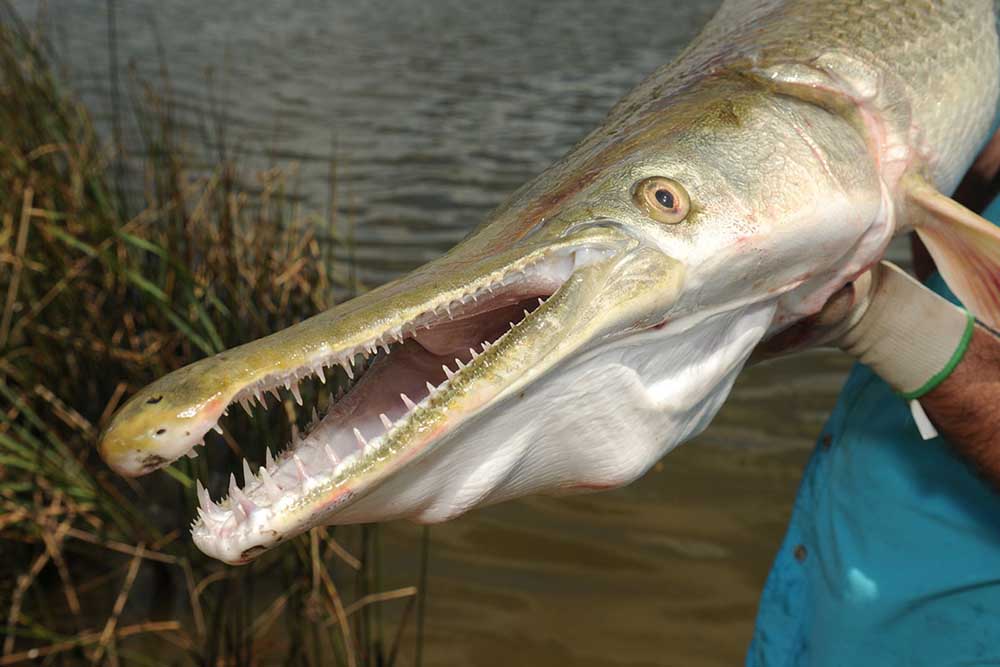TPWD looks for information on alligator gar fishermen
Published 12:18 am Friday, July 6, 2018

- In an effort to protect alligator gar, but still allow fishing for them, the Texas Parks and Wildlife Department is conducting an online survey to find out more about who is fishing for them and where.
From considered a trash fish to a sport-fishing target, the alligator gar has gotten a huge public relations upgrade through the years.
Now there is concern about the future of the species whose numbers seem to be declining around the state for a variety of reasons.
Trending
“Alligator gar are a native Texas fish. They are part of the natural biodiversity within our fish assemblages. They serve as both a predator and scavenger, feeding primarily on the biomass from large carp, shad, buffalo and tilapia where present, and recycling those nutrients to lower elements in the system,” said Dave Terre, Texas Parks and Wildlife Department’s Fisheries Division’s Management/Research chief.
They are also as hard to find as a snipe at night using a red-lensed flashlight and, for that reason, TPWD is conducting an online survey through July to gauge fishermen’s interests in the fish and to help guide department biologists in management. The survey is the first step toward possibly more restrictive regulations on alligator gar, if not statewide, then at least regionally.
“Our Commission has directed us to explore restrictions to further restrict harvest of large alligator gar, especially in the Trinity River,” Terre explained.
The Trinity River seems to be one of the most popular fishing spots in the state based on the publicity it has received in articles and television shows.
It is impossible to give a statewide view of the fish. However, Terre said the TPWD staff believes its overall status is good, as best they know.
“All populations are different with regards to fish density and age structure. We know that strong fisheries exist in reservoirs and rivers in east and south Texas. Probably the strongest river fishery we have is in the Trinity River. The strongest reservoir fishery is probably Choke Canyon Reservoir,” he said.
Trending
Additionally, good fisheries can be found in the Sabine, Brazos and Lower Guadalupe rivers and lakes Sam Rayburn, Falcon, Livingston and Corpus Christi. Probably surprising to some is that good populations also exist in the brackish waters of some of the bays and estuaries along the coast.
And then there is what biologists do not know.
“Alligator gar likely exist in other river systems and reservoirs too, but their status is largely unknown,” Terre said.
Mature alligator gar do not necessarily spawn annually. When they do, however, changes in river water flow rates caused by damming and in some years the lack of rainfall has affected spawning efforts. The fish need flooded habitat in the spring to successfully spawn. If there is not the flooding effect, or the fish do not have access to the flooded plains, it impacts spawning and population numbers.
Dams are not going away in Texas, but the department can work with the various water authorities to increase river flow rates in the spring.
“If a population was found to be struggling, we could advocate for the flooding of backwater areas to enhance alligator gar spawning. We are currently busy identifying and mapping floodplain areas that have potential to provide spawning habitats in certain systems. We are also exploring ways to potentially work with river controlling authorities to provide water, when available, to flood those habitats during the spring spawning season,” Terre said.
At this point, the department is not sure how popular the sport is with Texans, but the most recent survey said as many as 100,000 pursue gar. Those numbers vary, especially with bow fishermen, who tend to come and go in the sport. However, according to a TPWD angler survey, the percentage of bow fishermen seems surprisingly low.
“In our 2012 statewide angler survey, we found that of the freshwater anglers who reported having fished for alligator gar during the previous year, only 3 percent reported bowfishing. This suggests to us that most people who fish for alligator gar do so using other means, such as rod-and-reel,” Terre said.
The statewide limit for alligator gar is one per day. The lone exception is at Falcon Lake where the limit was changed to five per day in 2015 at the request of fishermen concerned that the gar were impacting bass numbers at times when the lake level dropped significantly. Terre said the department would be conducting a survey in 2019 in which it hopes to learn if the change has made a difference.
The department’s online survey is available at https://survey.tpwd.state.tx.us/TakeSurvey.aspx?PageNumber=1&SurveyID=l2KH3655&Preview=true#. A Spanish language version is available at https://survey.tpwd.state.tx.us/TakeSurvey.aspx?PageNumber=1&SurveyID=n2KH489K&Preview=true#.



